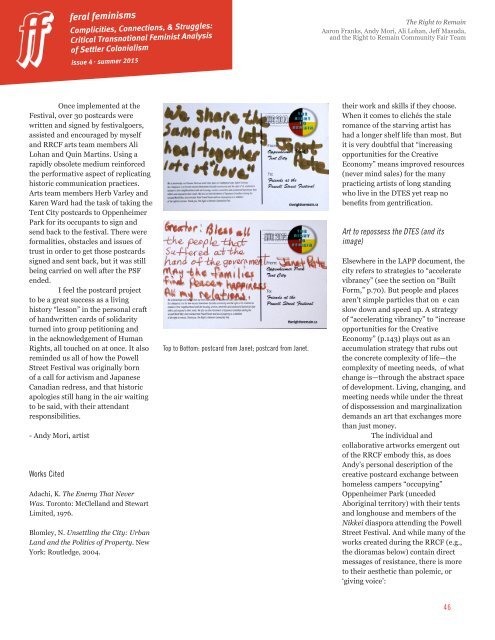feminisms
ff_issue4
ff_issue4
- No tags were found...
You also want an ePaper? Increase the reach of your titles
YUMPU automatically turns print PDFs into web optimized ePapers that Google loves.
feral <strong>feminisms</strong>Complicities, Connections, & Struggles:Critical Transnational Feminist Analysisof Settler Colonialismissue 4 . summer 2015The Right to RemainAaron Franks, Andy Mori, Ali Lohan, Jeff Masuda,and the Right to Remain Community Fair TeamOnce implemented at theFestival, over 30 postcards werewritten and signed by festivalgoers,assisted and encouraged by myselfand RRCF arts team members AliLohan and Quin Martins. Using arapidly obsolete medium reinforcedthe performative aspect of replicatinghistoric communication practices.Arts team members Herb Varley andKaren Ward had the task of taking theTent City postcards to OppenheimerPark for its occupants to sign andsend back to the festival. There wereformalities, obstacles and issues oftrust in order to get those postcardssigned and sent back, but it was stillbeing carried on well after the PSFended.I feel the postcard projectto be a great success as a livinghistory “lesson” in the personal craftof handwritten cards of solidarityturned into group petitioning andin the acknowledgement of HumanRights, all touched on at once. It alsoreminded us all of how the PowellStreet Festival was originally bornof a call for activism and JapaneseCanadian redress, and that historicapologies still hang in the air waitingto be said, with their attendantresponsibilities.- Andy Mori, artistWorks CitedAdachi, K. The Enemy That NeverWas. Toronto: McClelland and StewartLimited, 1976.Blomley, N. Unsettling the City: UrbanLand and the Politics of Property. NewYork: Routledge, 2004.Top to Bottom: postcard from Janet; postcard from Janet.their work and skills if they choose.When it comes to clichés the staleromance of the starving artist hashad a longer shelf life than most. Butit is very doubtful that “increasingopportunities for the CreativeEconomy” means improved resources(never mind sales) for the manypracticing artists of long standingwho live in the DTES yet reap nobenefits from gentrification.Art to repossess the DTES (and itsimage)Elsewhere in the LAPP document, thecity refers to strategies to “acceleratevibrancy” (see the section on “BuiltForm,” p.70). But people and placesaren’t simple particles that on e canslow down and speed up. A strategyof “accelerating vibrancy” to “increaseopportunities for the CreativeEconomy” (p.143) plays out as anaccumulation strategy that rubs outthe concrete complexity of life—thecomplexity of meeting needs, of whatchange is—through the abstract spaceof development. Living, changing, andmeeting needs while under the threatof dispossession and marginalizationdemands an art that exchanges morethan just money.The individual andcollaborative artworks emergent outof the RRCF embody this, as doesAndy’s personal description of thecreative postcard exchange betweenhomeless campers “occupying”Oppenheimer Park (uncededAboriginal territory) with their tentsand longhouse and members of theNikkei diaspora attending the PowellStreet Festival. And while many of theworks created during the RRCF (e.g.,the dioramas below) contain directmessages of resistance, there is moreto their aesthetic than polemic, or‘giving voice’:46


